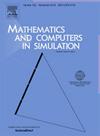Dynamical behavior and bifurcation analysis for a theoretical model of dengue fever transmission with incubation period and delayed recovery
IF 4.4
2区 数学
Q1 COMPUTER SCIENCE, INTERDISCIPLINARY APPLICATIONS
引用次数: 0
Abstract
As offered by the World Health Organisation (WHO), close to half of the population in the world’s resides in dengue-risk zones. Dengue viruses are transmitted to individuals by Aedes mosquito species infected bite (Ae. Albopictus of Ae. aegypti). These mosquitoes can transmit other viruses, including Zika and Chikungunya. In this research, a mathematical model is formulated to reflect different time delays considered in both extrinsic and intrinsic incubation periods, as well as in the recovery periods of infectious individuals. Preliminary results for the non-delayed model including positivity and boundedness of solutions, non-dimensionalization and equalibria analysis are presented. The threshold parameter (reproduction number) of the model is obtained via next generation matrix schemes. The stability analysis of the model revealed that various dynamical behavior can be observed depending on delay parameters, where in particular the effect of delay in the recovery time of infectious individuals may lead to substantial changes in the dynamics. The ideas presented in this paper can be applied to other infectious diseases, providing qualitative evaluations for understanding time delays influencing the transmission dynamics.
具有潜伏期和延迟恢复的登革热传播理论模型的动力学行为和分岔分析
根据世界卫生组织(WHO)提供的数据,世界上近一半的人口居住在登革热风险地区。登革热病毒通过伊蚊叮咬传播给个体。白纹伊蚊蚊)。这些蚊子可以传播其他病毒,包括寨卡病毒和基孔肯雅病毒。在本研究中,建立了一个数学模型,以反映考虑外在潜伏期和内在潜伏期以及感染个体恢复期的不同时间延迟。给出了非延迟模型的初步结果,包括解的正性和有界性、无量纲化和均衡性分析。通过下一代矩阵格式获得模型的阈值参数(再现数)。模型的稳定性分析表明,不同的延迟参数可以观察到不同的动力学行为,特别是延迟对感染个体恢复时间的影响可能导致动力学的实质性变化。本文提出的思想可以应用于其他传染病,为理解影响传播动力学的时间延迟提供定性评价。
本文章由计算机程序翻译,如有差异,请以英文原文为准。
求助全文
约1分钟内获得全文
求助全文
来源期刊

Mathematics and Computers in Simulation
数学-计算机:跨学科应用
CiteScore
8.90
自引率
4.30%
发文量
335
审稿时长
54 days
期刊介绍:
The aim of the journal is to provide an international forum for the dissemination of up-to-date information in the fields of the mathematics and computers, in particular (but not exclusively) as they apply to the dynamics of systems, their simulation and scientific computation in general. Published material ranges from short, concise research papers to more general tutorial articles.
Mathematics and Computers in Simulation, published monthly, is the official organ of IMACS, the International Association for Mathematics and Computers in Simulation (Formerly AICA). This Association, founded in 1955 and legally incorporated in 1956 is a member of FIACC (the Five International Associations Coordinating Committee), together with IFIP, IFAV, IFORS and IMEKO.
Topics covered by the journal include mathematical tools in:
•The foundations of systems modelling
•Numerical analysis and the development of algorithms for simulation
They also include considerations about computer hardware for simulation and about special software and compilers.
The journal also publishes articles concerned with specific applications of modelling and simulation in science and engineering, with relevant applied mathematics, the general philosophy of systems simulation, and their impact on disciplinary and interdisciplinary research.
The journal includes a Book Review section -- and a "News on IMACS" section that contains a Calendar of future Conferences/Events and other information about the Association.
 求助内容:
求助内容: 应助结果提醒方式:
应助结果提醒方式:


